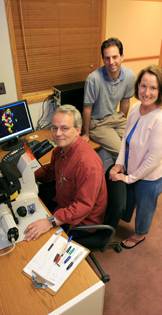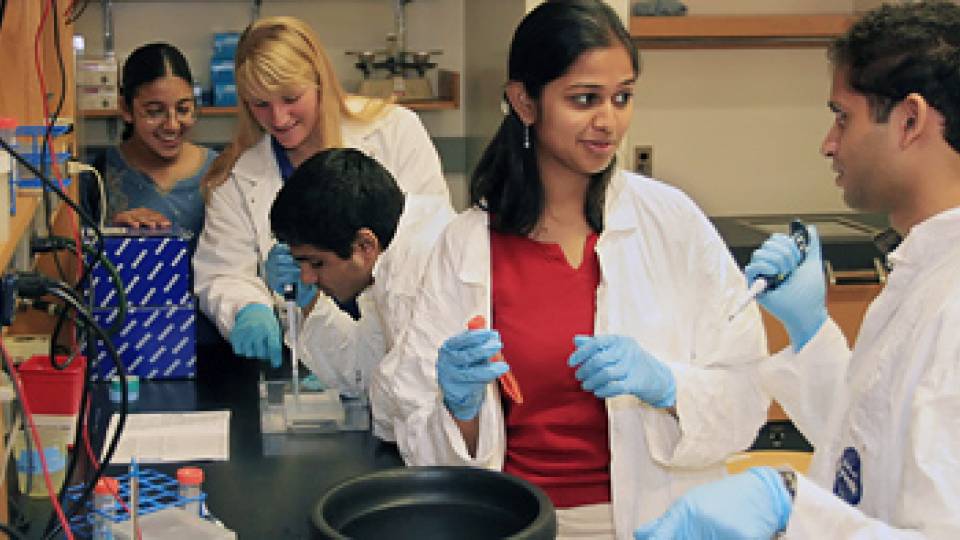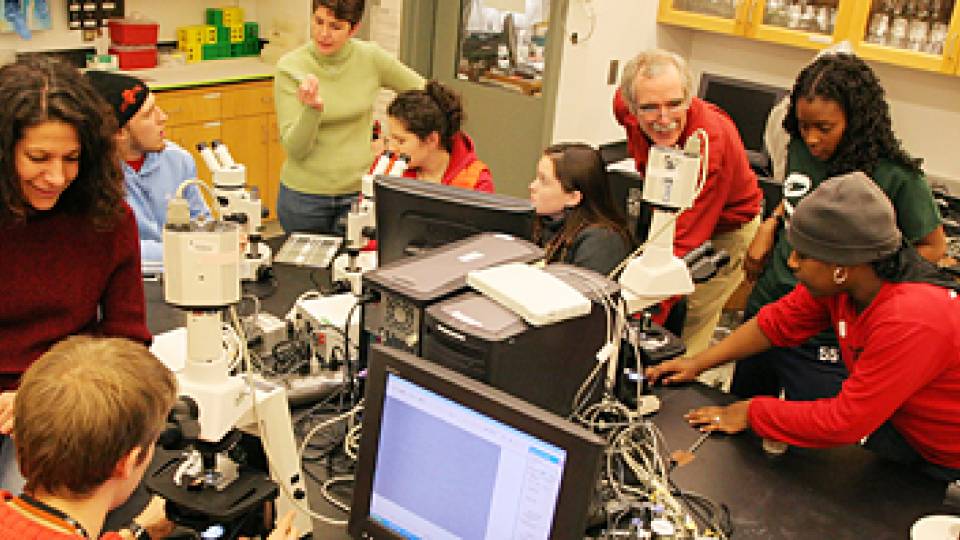From the June 19, 2006, Princeton Weekly Bulletin
Long before “superman” Christopher Reeve’s spinal cord injury and actor Michael J. Fox’s Parkinson’s disease fueled the public fervor over regenerative therapies, Princeton scientists were making breakthroughs in stem cell research.
It was only natural that Princeton researchers would make the list when New Jersey became the first state in December of last year to award grants for work on stem cells.
Two of the University’s grant recipients, molecular biologists Ihor Lemischka and Kateri Moore, continue exploring the cutting edge of stem cell research. One of these efforts is a collaboration with electrical engineer Ron Weiss to program embryonic stem cells to “fix” disease. The third grant recipient, molecular biologist Thomas Shenk, will focus on producing stem cells from human umbilical cord blood.
The grants from the New Jersey Commission on Science and Technology will further work in the field of stem cell advancements that began at Princeton more than 25 years ago.
Still, the current public interest in their work creates challenges for Princeton researchers unseen in past decades. Rampant misinformation about the progress of stem cell research affects funding and raises the need for public education.
“There’s a lot of public misconception about stem cells, and the public misconception runs very deep,” said Lemischka, a professor of molecular biology. “And it can border on the irresponsible, because there are a lot of people with sick children and family members and friends who read something in the national news or see something on television and then they get the false impression that there’s hope within the next year or so.”
Lemischka said the field of stem cell research calls for a breed of scientists who are innovators but also public educators — scientists who can explain that, while researchers are optimistic the work they’re doing will likely lead to medical breakthroughs for certain cancers and neurological disorders many years from now, it’s critical not to make unrealistic promises about stem-cell cures.
Considering the direction of the research, though, it’s easy to see why the researchers and the public are excited.
Lemischka and Moore, a senior research molecular biologist, are merging their work in the ever-evolving field of developmental biology with Weiss’ work in the relatively new field of synthetic biology, which aims to program biological cells the way computer scientists can program computers.
Weiss, an assistant professor of electrical engineering, has been working with Lemischka and Moore for the past three years to program digital logic into biological cells.
To put it simply, “Ron is the future,” Moore said.
The goal is to determine how a cell decides what it will become and how it will change, which could someday translate into clinical and medical applications that include fighting disease. With the help of computer modeling, the researchers are working to develop what would equate to genetic — rather than technological — software patches to “fix” defective cells.
“For almost every decision that a stem cell makes, there is an analogous situation in an electronic circuit,” Lemischka said. “They do the same kinds of computations, but they do it out of different types of materials and they do it maybe in different ways. Electronic circuits are built out of electronic components, silicone, and cells have to build the same things out of five chemicals. So one way I view our collaboration here is Teri (Moore) and I identify the parts and identify how evolution has wired up the parts normally, then Ron takes the parts and wires them up in ways that we can control.”
The next logical step
Stem cells are at the center of the research because these basic biological building blocks can give rise to other types of cells. For the past four years, Lemischka has begun to focus specifically on embryonic stem cells because these cells begin with the unique ability to become any type of cell and can be stimulated to commit toward becoming specific types of blood, skin or other tissues. His group has performed extensive functional genomics efforts to identify genes that control stem cell fates, with results published in Proceedings of the National Academy of Sciences and in the June 11 online edition of the journal Nature.
Lemischka has been studying stem cells at Princeton for 20 years and has remained one of the world’s leading innovators in the research since he was the first to show in the 1980s that a single blood-producing stem cell in bone marrow, known as a hematopoietic stem cell, could rebuild the entire blood system in a mouse whose blood system had been destroyed.
Moore’s research group has been working with Lemischka for 14 years to contribute an understanding of the microenvironments where stem cells live and are nurtured.
Lemischka and Moore came together with Weiss after he wrote a paper on directed evolution published in the Proceedings of the National Academy of Sciences. The paper described analogies between building computer circuits and using nature to build similar natural connections.
After years of breakthroughs identifying molecules that control stem cell function in mice, the logical next step for the biologists was to explore the engineering of stem cells.
“That’s where the programming comes in,” said Weiss, whose background is in computer science. “The modeling is what allows you to design the system. What I would like to see is that I can develop a computer model that would incorporate all the elements that are in a cell and be able to predict what would happen if I altered this or that element. The analogy would be that we have a system that is broken, so let’s put a software patch on there that actually rectifies what the system is doing.”
For certain cancers, for example, when the problem is that cells replicate without stopping, a patch would fix the cell system to make the replication stop.
“So imagine also that you have a spinal cord injury and you try to use the stem cells for therapy without the patch in there,” Weiss said. “They don’t know how to regenerate the tissue. They don’t know how to make the bone interactions, the nerve interactions.”
The researchers would then apply a patch, which would allow them to teach the cells the new information.
“The cell, once it differentiates into a neuronal cell, will be able to do the normal things it does,” Weiss said, “but we’re going to allow it to make these special three-dimensional structures to regenerate the tissue that it doesn’t know how to do without the cell core patch.”
Weiss and Lemischka are seeking to pass along their knowledge to the next generation of stem cell researchers through a 10-week summer course on building artificial circuits in embryonic stem cells for undergraduates in physics and engineering at Princeton.
Building on history
Lynn Enquist, chair of the Department of Molecular Biology, said that despite the current public interest in stem cell research, Lemischka and Moore’s work is the continuation of a long history of contributions in the field at Princeton.
“The phrase ‘stem cell’ is a recent addition to the public lexicon, but it’s important not to confuse public interest with the scientific community’s long-term interest in how embryos form,” Enquist said.
Princeton scientists have been at the forefront of developmental biology for more than 25 years, with Eric Wieschaus sharing the 1995 Nobel Prize for his discoveries concerning the genetic control of early embryonic development in fruit flies, Enquist said. He added that this was just one in a long list of accomplishments from biology at Princeton.
The University’s fly genetics group, vertebrate geneticists, biophysicists and microbiologists all have been focusing on cell development and creation of cell systems from single cells for many years.
Lemischka’s lab happened to be the first in the world to begin molecular biology on stem cell systems, starting with his arrival at Princeton in 1986. He had previously worked at the Massachusetts Institute of Technology as a postdoctoral researcher studying bone marrow stem cells and also progenitor cells, which are immature marrow cells that divide and form differentiated cells.
Moore brought her expertise in gene therapies and cell environments to Lemischka’s lab in 1992.
“I come from a gene therapy background and what drove me back to basic research was the pressure to go to the bedside and take this therapy to patients,” Moore said. “I felt like we knew very little about basic stem cell properties and next to nothing about how they grow in their native environment.”
The researchers have seen a “snowball effect” in terms of interest in their research only within the past decade.
“We’ve had embryonic stem cells in the mouse for 20 years, but what I think really started the public mania was about five to seven years ago now, a few different laboratories developed human embryonic stem cells,” Lemischka said. “That then started the snowball effect, and people put two and two together and said, ‘Well, this is neat. We’ll be able to make heart tissue to repair cardiac arrests. We’ll be able to make insulin-producing cells to repair diabetic tissue.’ And this is where the unrealistic promises and the expectations came in.”
Weiss said it’s heartbreaking to receive e-mails from parents hoping he can save their children.
“Every time something is mentioned about all the promises of synthetic biology, I get all these very long e-mails with the name of the child explaining all the medical problems,” Weiss said. “You have to answer these politely, ‘No, I can’t save you,’ and you all of a sudden connect to the human element.”
Educating the public
The researchers see a cautionary tale when they reflect on the similar fervor over gene therapies about 25 years ago.
Scientists made “pie-in-the-sky” projections for cures based on the premise that genes could be altered to fight disease, Lemischka said. Today, a quarter century later, there have been deaths associated with gene therapy experimentation, and the very limited numbers of existing cures involve complications, he said.
“I think the real challenge that needs to be tackled by the biomedical community for its own good, as well as the public’s good, is we need to be more proactive in educating the public,” Lemischka said. “If you take five minutes to think about how to outline the problems and the issues, then anyone can understand this.”
The simple message is that, despite the exciting new discoveries that computer modeling and other research tools may bring about, no one knows when stem cell therapies and regenerative medicine will happen, Lemischka said.
“It’s important to identify those things that are doable from those things that are not,” he said. “I can’t imagine a stem-cell therapy for schizophrenia. I have a hard time imagining one for Alzheimer’s. Parkinson’s on the other hand, spinal injuries on the other hand, diabetes … these are all within reach.
“But when do I think stem cell therapies, regenerative medicines will happen?” Lemischka added. “I don’t know — maybe 10 years, maybe five; it’s really difficult to predict.”
In one sense, stem cell research involves a finite problem for which the researchers know the basic axioms, Weiss said. Yet the public does not realize how difficult it is to move from basic axioms to actual understanding of the human body, a system infinitely more complex than a man-made machine.
“Why do we understand computers, and why can we simply make version 2.0 and 3.0 to improve their operation? Because we designed them,” Weiss said. “It could take 200 years for us to understand the cell the same way we understand a computer.”
The funding challenge
The public’s misunderstanding and overreaching optimism fuel political opposition that has a chilling effect on the single most important element for stem cell research — funding.
“One example is there’s a Web site that is devoted to saying adult stem cells can do everything, so we don’t have to work on embryonic cells,” Lemischka said. “On that Web site it says that adult cells can be used on 60 different diseases. What they don’t say, and this is the key point, is that none of these therapies has been successful, with the exception of bone marrow transplantation and maybe skin grafting. And the public reads this and they have no way of knowing whether it’s true or not, and they buy into this.”
A public that believes that adult stem cell research places cures for disease within reach is not likely to support further research on human embryonic stem cells. Yet the lion’s share of embryonic stem cell research relies on public support because it is federally funded.
Lemischka and Moore currently work only with embryonic cells from mice, but the New Jersey grants that both received last year provide funding for Moore to continue work understanding stem-cell self renewal and for Lemischka to begin work on human stem-cell lines within two years.
“All of the public misconceptions, all the controversies over ethics, it’s not relevant to what I’m doing now, but it’s relevant to what I’m planning to do with human embryonic stem cells,” Lemischka said.
Moore added that the support for federal funding “is the difference between everything and nothing.”
She said the researchers are fortunate that New Jersey became the first state to award money for stem cell research. However, public education to gain further state support will be critical to increasing the $5 million that New Jersey awarded scientists across the state last year.
State funds are attractive because scientists using federal funding for human embryonic stem cell research must use stem cell lines created without harming or destroying an embryo, or lines created before President George W. Bush signed a law allowing research on existing lines in August of 2001.
“I think New Jersey is to be lauded that they actually put money into our hands,” Moore said of the combined $600,000 in grant monies she and Lemischka received.
Professor of molecular biology Shenk also received a $300,000 state grant, though his work will focus on investigating the biological properties of cells cloned from human umbilical cord blood, rather than working on embryonic cells.
Lemischka, Moore and Weiss will continue to watch the state and federal debates over stem cell funding while they continue looking for ways to capitalize on other resources available to them — specifically, intellectual resources.
“The thing I think is really neat at Princeton is you’re talking to people like Ron and just having these interactions and possibilities here that really change the way I think about things,” Lemischka said.
“I’m not a physician,” he added. “I’m a Ph.D., and I have very basic biological interests, but it’s absolutely delightful to me to know that what we’re doing is likely to be dramatically important at some time in the future.”


